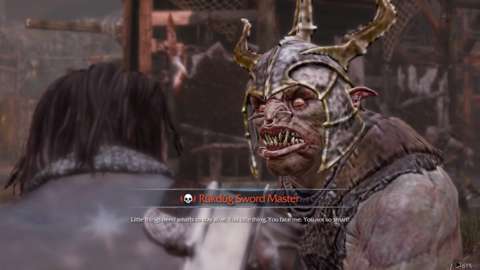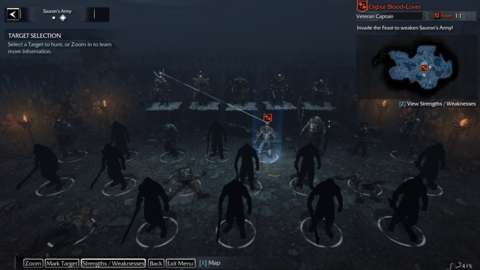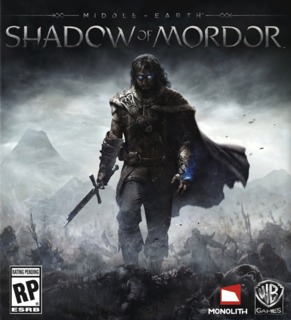You shall always have a Nemesis, even if you don't know it.
You are fighting your way to some of the dozens of slaves in the game in order to save them from execution when an in-game cut-scene introduces you to your first captain. Some treacherous Uruk triggers the alarm of the stronghold you are in and suddenly you find yourself swarmed. A random Uruk kills you, and thanks you for his well-earned promotion. The next time you see him he’ll be a Captain, and he'll remember you, making a point to remind you how he killed you and, well, how you should have stayed dead. While trying to revenge your own death you realize this Uruk has grown stronger, and has now a pack of followers and the ability to call in reinforcements by simply shouting. You die again.
Ok, first things first: Middle-earth: Shadow of Mordor is an open-world action-adventure game with some rpg elements, based on Tolkiens “The Lord of the Rings” books. It brings to the table the highly praised Nemesis system, which consists on a dynamic political structure filled randomly generated enemies, with almost unique traits, abilities names and personalities. Overall, this is the foundation that makes this game as enjoyable as it is. It’s impossible to isolate the "Nemesis System" from the rest of the game, but I'll summarize my experience with it in the end of the review.
The story follows a ranger who has been possessed by a Wraith, and therefore is now deprived from death. This does not mean he is immortal, no sir, he will die, a lot. Death in this game is a core mechanic: every time you die time moves forward allowing Uruks to grow stronger and interact with each other in their neat political system. You see, Uruks are stuck in an endless quest for power. They will back-stab one another to reach a higher position and amass power.
Combat is close to what the Batman Arkham series have already done. The game develops over that, of course, and you’ll get many supernatural abilities that Batman would never even dream of. You’ll blissfully jump over the heads of your enemies, stunning them, and then finish your combo by exploding someone’s head.

The world is full of regular Uruks, but you will hardly concern yourself with anything under the rank of Captain. You discover these captains by gathering Intel from other Uruks, or by encountering them in the fields. Intel will also give you access to a Captain's strengths and weaknesses: some might be invulnerable to stealth or ranged attacks but scared to death by flies or fire. This gives combat some extra depth. Leveling up will also add some depth to the gameplay, but might take most of the planning away once your character feels over powered. Nonetheless, the combat will remain enjoyable.
Your character grows more powerful by earning Ability Points, Power, Mirian and Runes. Ability Points and Mirian are earned by freeing slaves and accomplishing things in the game, as well as finding collectibles, and completing challenges. Collectibles are kept mostly fresh, mostly because you can find them even during missions, allowing you to find an artifact while stealthily pursuing another goal. Some may argue this breaks immersion, but then again, being optional you can choose to ignore them during missions.
Power and runes on the other hand are tied up with the Nemesis system. Each Captain will have a power level associated to how strong he is. Once killed, you’ll get his power and a rune. The stronger the Captain, the better the rune. Later in the game you’ll get the ability to send a death threat to a Captain, immediately increasing his power and the chance of getting better runes.

As the story progresses, you’ll learn the ability to dominate Urks, bending them to your will. This adds another layer of sharp greatness to the Nemesis system, given you can now impact the workings of the Uruk structure from within. The main missions and story of the game feel dull to the pure joy of hunting down captains, but there’s definitely something here for the hardcore Tolkien fans.
The movement… Oh, the agony! How many times did I lose my life stuck on the edge of a wooden fence? The Assassin’s Creed like movement brings with it many of its mayor issues. Getting stuck to edges while you seemingly keep running in place and running up a wall five times in a row instead of climbing it, because you aren’t approaching it in a 100% straight line is irritating. Those issues made me put the controller down more than once. Fast travel works just fine, though the world is beautiful and not all that big, after a while you’ll be thankful you can warp to any activated “watch tower” as soon as you break line of sight with your enemies.
You can also start missions even if spotted, which is a nice touch if you don’t want to stealthily get to the middle of an Uruk-infested stronghold just to start a mission. The Stronghold will reset, and the mission will start, even if an alarm signal has been triggered.
The game is at its best when you are freely interacting with the Uruks Captains of the Nemesis System. You’ll be brought to your lowest instincts of revenge and pursue to death that Captain that’s already killed you three times. He’ll be every time more powerful, and, while attempting to kill him some other lowlife might give the finishing blow and enter your black list. Eventually, you’ll grow strong enough to enjoy your revenge, as your enemy’s head spins in slow motion, severed from his lifeless body… It’s not all rainbows and butterflies though.

Through my first hours with the game I had almost half of the Uruk Captains as a revenge target. This affected my relationship with the nemesis system negatively: with so many rivalries, there wasn’t such a strong bond with my enemies. The game tries to keep this from happening by having the captains kill each other over time, but it is most likely to kill the Uruks you haven’t seen, than those who killed you… That doesn’t help the numbers!
Eventually you’ll get so powerful you’ll go around wiping out every enemy who has ever done you wrong, leaving the ranks with more corpses than captains. Nearing its end, the game tries to make a meaningful conclusion to all your interactions with the captains and throws you to duel with your nemesis, that is, the Uruk with whom you’ve had the most lasting relationship of hatred. Of course, if you’ve just killed every Uruk who has ever wronged you, you’ll face a random nemesis you know nothing about. Talk about anticlimactic. Oh, and, the game ends with a god forsaken QTE… After all those great moments of gameplay with the nemesis system, WHY?!
In conclusion, Middle-earth Shadow of Mordor is a very good game with great moments and gameplay. The story adds little value, but it’s enough to keep the game going. The Nemesis System is full of amazing ideas that sadly connect poorly with some of the more scripted moments of the game. Overall, the Nemesis System, more than the game itself, is bigger than its own flaws, making this game very enjoyable.

